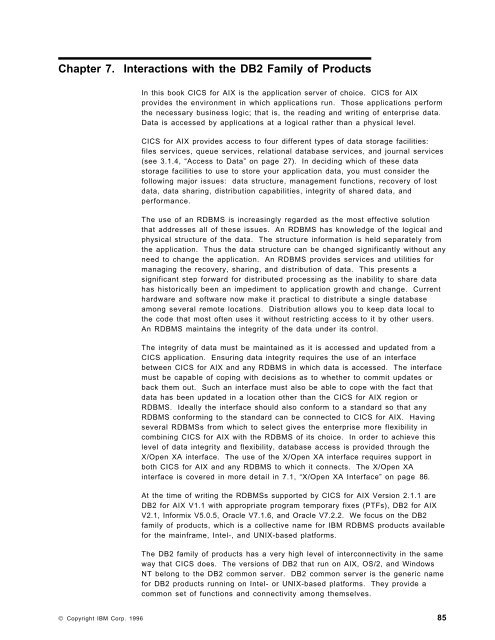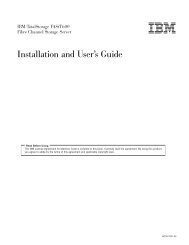Addressing OLTP Solutions with CICS: The Transaction Server ... - Ibm
Addressing OLTP Solutions with CICS: The Transaction Server ... - Ibm
Addressing OLTP Solutions with CICS: The Transaction Server ... - Ibm
Create successful ePaper yourself
Turn your PDF publications into a flip-book with our unique Google optimized e-Paper software.
Chapter 7. Interactions <strong>with</strong> the DB2 Family of Products<br />
In this book <strong>CICS</strong> for AIX is the application server of choice. <strong>CICS</strong> for AIX<br />
provides the environment in which applications run. Those applications perform<br />
the necessary business logic; that is, the reading and writing of enterprise data.<br />
Data is accessed by applications at a logical rather than a physical level.<br />
<strong>CICS</strong> for AIX provides access to four different types of data storage facilities:<br />
files services, queue services, relational database services, and journal services<br />
(see 3.1.4, “Access to Data” on page 27). In deciding which of these data<br />
storage facilities to use to store your application data, you must consider the<br />
following major issues: data structure, management functions, recovery of lost<br />
data, data sharing, distribution capabilities, integrity of shared data, and<br />
performance.<br />
<strong>The</strong> use of an RDBMS is increasingly regarded as the most effective solution<br />
that addresses all of these issues. An RDBMS has knowledge of the logical and<br />
physical structure of the data. <strong>The</strong> structure information is held separately from<br />
the application. Thus the data structure can be changed significantly <strong>with</strong>out any<br />
need to change the application. An RDBMS provides services and utilities for<br />
managing the recovery, sharing, and distribution of data. This presents a<br />
significant step forward for distributed processing as the inability to share data<br />
has historically been an impediment to application growth and change. Current<br />
hardware and software now make it practical to distribute a single database<br />
among several remote locations. Distribution allows you to keep data local to<br />
the code that most often uses it <strong>with</strong>out restricting access to it by other users.<br />
An RDBMS maintains the integrity of the data under its control.<br />
<strong>The</strong> integrity of data must be maintained as it is accessed and updated from a<br />
<strong>CICS</strong> application. Ensuring data integrity requires the use of an interface<br />
between <strong>CICS</strong> for AIX and any RDBMS in which data is accessed. <strong>The</strong> interface<br />
must be capable of coping <strong>with</strong> decisions as to whether to commit updates or<br />
back them out. Such an interface must also be able to cope <strong>with</strong> the fact that<br />
data has been updated in a location other than the <strong>CICS</strong> for AIX region or<br />
RDBMS. Ideally the interface should also conform to a standard so that any<br />
RDBMS conforming to the standard can be connected to <strong>CICS</strong> for AIX. Having<br />
several RDBMSs from which to select gives the enterprise more flexibility in<br />
combining <strong>CICS</strong> for AIX <strong>with</strong> the RDBMS of its choice. In order to achieve this<br />
level of data integrity and flexibility, database access is provided through the<br />
X/Open XA interface. <strong>The</strong> use of the X/Open XA interface requires support in<br />
both <strong>CICS</strong> for AIX and any RDBMS to which it connects. <strong>The</strong> X/Open XA<br />
interface is covered in more detail in 7.1, “X/Open XA Interface” on page 86.<br />
At the time of writing the RDBMSs supported by <strong>CICS</strong> for AIX Version 2.1.1 are<br />
DB2 for AIX V1.1 <strong>with</strong> appropriate program temporary fixes (PTFs), DB2 for AIX<br />
V2.1, Informix V5.0.5, Oracle V7.1.6, and Oracle V7.2.2. We focus on the DB2<br />
family of products, which is a collective name for IBM RDBMS products available<br />
for the mainframe, Intel-, and UNIX-based platforms.<br />
<strong>The</strong> DB2 family of products has a very high level of interconnectivity in the same<br />
way that <strong>CICS</strong> does. <strong>The</strong> versions of DB2 that run on AIX, OS/2, and Windows<br />
NT belong to the DB2 common server. DB2 common server is the generic name<br />
for DB2 products running on Intel- or UNIX-based platforms. <strong>The</strong>y provide a<br />
common set of functions and connectivity among themselves.<br />
© Copyright IBM Corp. 1996 85
















